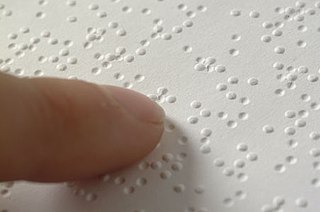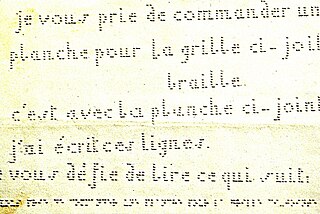 W
WBraille is a tactile writing system used by people who are visually impaired. It is traditionally written with embossed paper. Braille users can read computer screens and other electronic supports using refreshable braille displays. They can write braille with the original slate and stylus or type it on a braille writer, such as a portable braille notetaker or computer that prints with a braille embosser.
 W
WEnglish Braille, also known as Grade 2 Braille, is the braille alphabet used for English. It consists of around 250 letters (phonograms), numerals, punctuation, formatting marks, contractions, and abbreviations (logograms). Some English Braille letters, such as ⠡ ⟨ch⟩, correspond to more than one letter in print.
 W
WLouis Braille was a French educator and inventor of a reading and writing system for use by people who are visually impaired. His system remains virtually unchanged to this day, and is known worldwide simply as braille.
 W
WA cecogram, also known as literature for the blind, is a letter or a parcel that contains documents or items intended for visually impaired persons. Cecograms can be sent or received by such persons, as well as by organisations that provide assistance to the visually impaired. Cecograms are either partially or entirely exempt from postage.
 W
WCountess Róża Czacka, was a Polish Roman Catholic professed religious who founded the Franciscan Sisters Servants of the Cross. Czacka suffered an accident in her childhood that later led to her becoming blind after she turned 22 despite the numerous surgical interventions that were performed on her. The next decade saw Czacka travel throughout Europe hoping to learn about techniques that she could use to help the blind; she adapted Polish phonetics into the Braille alphabet that ended up becoming mandated in all schools for the blind since 1934. Czacka entered the Franciscan Third Order in 1917 before founding her own religious congregation in late 1918 based on ideas that she had formulated since at least 1915. Her work received approval from the apostolic nuncio Achille Ratti who lauded her efforts as an exceptional apostolate. In 1950 she retired her role as the Superior General for her order due to her declining health.
 W
WDecapoint, or raphigraphy, was a tactile form of the Latin script invented by Louis Braille as a system that could be used by both the blind and sighted. It was published in 1839. Letters retained their linear form, and so were legible without training to the sighted, but the lines were composed of embossed dots like those used in braille. Each letter contained ten dots in the height and different dots in the width to produce the graphic form of print.
 W
WFrank Haven Hall was an American inventor and essayist who is credited with inventing the Hall braille writer and the stereographer machine. He also invented the first successful mechanical point writer and developed major functions of modern day typography with kerning and tracking.
 W
WHebrew Braille is the braille alphabet for Hebrew. The International Hebrew Braille Code is widely used. It was devised in the 1930s and completed in 1944. It is based on international norms, with additional letters devised to accommodate differences between English Braille and the Hebrew alphabet. Unlike Hebrew, but in keeping with other braille alphabets, Hebrew Braille is read from left to right instead of right to left., and unlike English Braille, it is an Abjad, all consonants.
 W
WThe sharpness of our senses is defined by the finest detail we can discriminate. Visual acuity is measured by the smallest letters that can be distinguished on a chart and is governed by the anatomical spacing of the mosaic of sensory elements on the retina. Yet spatial distinctions can be made on a finer scale still: misalignment of borders can be detected with a precision up to 10 times better than visual acuity, as already shown by Ewald Hering in 1899. This hyperacuity, transcending by far the size limits set by the retinal 'pixels', depends on sophisticated information processing in the brain.
 W
WMason Ewing Corporation is a holding company based in Los Angeles directed by Mason Ewing, who created it in 2011. The corporation targets mainly fashion, cinema and music industry but also various other sectors such as cosmetic and chocolate.
 W
WA perforation is a small hole in a thin material or web. There is usually more than one perforation in an organized fashion, where all of the holes collectively are called a perforation. The process of creating perforations is called perforating, which involves puncturing the workpiece with a tool.
 W
WTactile is a real-time text-to-braille translation device currently under development at the Massachusetts Institute of Technology. It was conceived by a team of undergraduate students, competing as "Team 100% Enthusiasm", during a 15-hour MIT "hackathon". The device is slid over printed text and a camera captures images of the words and sends them to a microcontroller. The information moves the pins up and down, translating the text into Braille. Once on the market it is hoped to be much cheaper than existing devices.